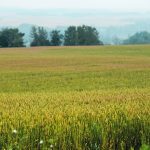A PhD student at the University of Saskatchewan has been working on developing a method of detecting fusarium damaged kernels to ease the struggles of producers, agronomists and industry.
Tag Archives mycotoxin

Fusarium head blight mycotoxin detector in the works
Portable machine to identify contaminated kernels under development at the University of Saskatchewan

Feed analysis flags mycotoxin concerns
Corn silage likely has the highest risk profile although other annual feed crops also show increased DON and ZEA levels
Glacier FarmMedia – Manitoba Agriculture is urging producers to test their feed after a harvest analysis report flagged greater risk of mycotoxin contamination in corn silage. Early findings from the Alltech 2024 Canadian Harvest Analysis suggested plenty of variability in contamination levels across Canada, but there were particular concerns on corn silage quality, according to […] Read more
Research identifies fungal toxin threat to wheat
Fusarium has been found across Europe with half the wheat intended for human consumption containing vomitoxin
Researchers examined data from across Europe and the U.K. from the past 10 years and found that fusarium mycotoxins were discovered in every European country with half of the wheat intended for human consumption containing the fusarium mycotoxin DON (often referred to as vomitoxin).


